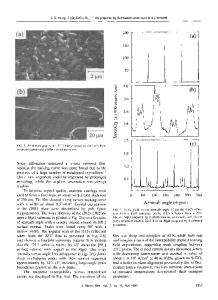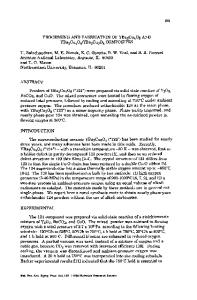Patterning of c- axis-oriented Ba 2 TiX 2 O 8 ( X = Si, Ge) crystal lines in glass by laser irradiation and their second
- PDF / 321,073 Bytes
- 4 Pages / 585 x 783 pts Page_size
- 87 Downloads / 242 Views
Patterning of c-axis-oriented Ba2TiX2O8 (X = Si, Ge) crystal lines in glass by laser irradiation and their second-order optical nonlinearities Tsuyoshi Honmaa) and Takayuki Komatsu Department of Materials Science and Technology, Nagaoka University of Technology, Nagaoka 940-2188, Japan
Yasuhiko Benino Department of Material and Energy Science, Graduate School of Environmental Science, Okayama University, Okayama 700-8530, Japan (Received 17 October 2007; accepted 9 January 2008)
Crystal lines consisting of nonlinear optical fresnoite-type Ba2TiX2O8 (X ⳱ Si, Ge) crystals are patterned on the surface of CuO (1 mol%)-doped 33.3BaO–16.7TiO2– 50SiO2 or –50GeO2 glasses by continuous-wave (cw) neodymium:yttrium aluminum garnet (Nd:YAG) laser (wavelength 1064 nm) irradiation. It is confirmed from polarized micro-Raman scattering spectra that the c axis of Ba2TiX2O8 crystals in the lines are oriented along the laser-scanning direction (i.e., parallel to the lines). The azimuthal dependences of second-harmonic (SH) intensities for the crystal lines indicate unique fringe patterns, and the c-axis orientation of the crystals is supported from the analyses of fringe patterns. The value of the d31/d33 ratio is found to be ∼23 for Ba2TiSi2O8 (BTS) crystal lines, and ∼13 for Ba2TiGe2O8 (BTG) crystal lines, where d31 and d33 are the principal d tensors for the second-order optical nonlinearity of fresnoite-type crystals.
Recently, the laser-induced structural modification of materials has attracted much attention because of the spatial selectivity of the process and the ability to generate the nanostructure or microstructure inside and on the surface of materials.1,2 The present authors’ group3–6 proposed a laser-induced crystallization technique in glasses containing rare-earth (RE) ions such as Sm3+ or Dy3+ by using cw YAG laser (wavelength ⳱1064 nm) irradiation, which is based on local heating due to the nonradiative relaxation process of RE ions. Gupta et al. 7 also proposed laser-induced crystallization on Nd3+doped glass. Furthermore, we developed a laser-induced crystallization technique using transition-metal ions (Ni2+, Fe2+, V4+, and Cu2+) instead of RE ions, and demonstrated that ferroelastic BTS and BTG crystal lines were patterned on the surface of BaO–TiO2–SiO2 or –GeO2 glasses.8 It has been also proposed from the azimuthal dependence of SH generation (SHG) signals that
a)
Address all correspondence to this author. e-mail: [email protected] DOI: 10.1557/JMR.2008.0135 J. Mater. Res., Vol. 23, No. 4, Apr 2008
http://journals.cambridge.org
Downloaded: 14 Mar 2015
the crystal lines patterned by Nd:YAG laser irradiation might have a uni-axis orientation along the laserscanning direction. The orientation axis of BTS and BTG crystals in the lines, however, has not been determined. It is known that fresnoite-type BTS and BTG crystals reveal interesting dielectric and optical features such as piezoelectricity and ferroelectricity.9 In addition, it has been reported that BaO–TiO2–SiO2 or –GeO2 glasses such as 3
Data Loading...











